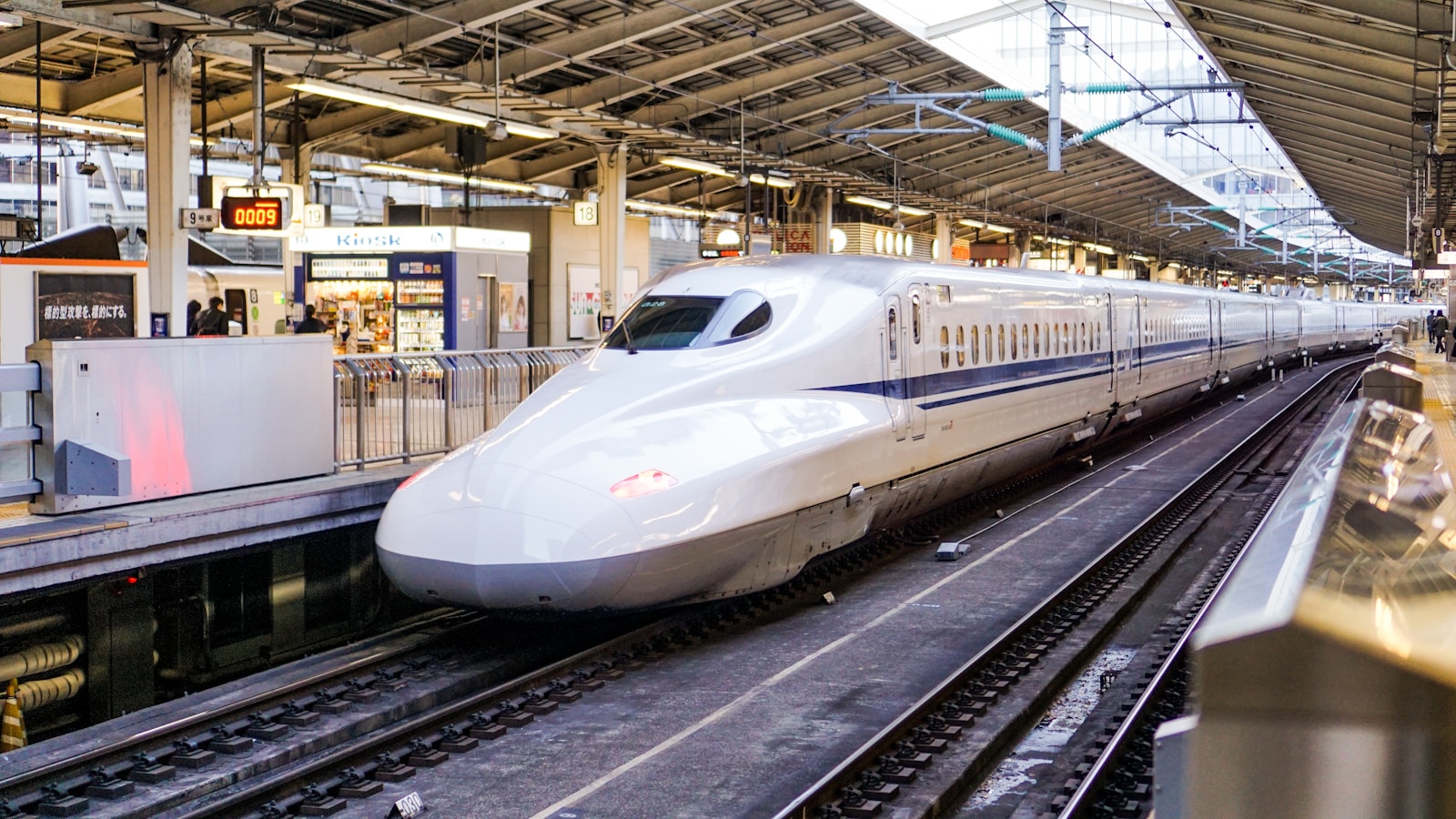In the heart of Japan’s technological prowess and innovation lies a symbol of speed, efficiency, and precision: the bullet train, or Shinkansen. Since its debut in 1964, the bullet train has not only revolutionized the way people travel across the country but has also become an emblem of Japan’s forward-thinking approach to transportation solutions. With their sleek design and remarkable speeds, these trains are a testament to Japan’s commitment to pushing the boundaries of what’s possible on rails. As we delve into the world of Japan’s bullet trains, we uncover the elements that make them a marvel of modern engineering, a linchpin of the nation’s economy, and a green initiative on the fast track to the future.
Japan’s Bullet Trains: A Speedy Overview
Japan’s bullet trains, known as Shinkansen, have been slicing through the country’s landscapes since their inauguration before the Tokyo Olympics in 1964. Designed for speed and punctuality, they have redefined inter-city travel, making it possible to commute between major cities with unprecedented ease. The network has grown significantly, connecting the islands of Honshu, Kyushu, and Hokkaido, covering a span of thousands of kilometers. The allure of these trains lies not just in their velocity but in their seamless integration into Japan’s bustling life, serving millions of passengers annually.
The Shinkansen: Engineering Marvels on Rails
The Shinkansen is a product of unparalleled engineering ingenuity. Its design eliminates traditional friction-based rail mechanisms, opting instead for a combination of specially designed tracks and advanced technologies. Each train is powered by multiple electric engines, enabling it to maintain high speeds with remarkable stability and minimal noise. The aerodynamic shape minimizes air resistance, while cutting-edge seismic technology ensures safety during Japan’s frequent earthquakes. This blend of technology and design makes the Shinkansen a global benchmark in railway engineering.
From 0 to 320: The Evolution of Speed
Since the 210 km/h of the original 0 Series Shinkansen, Japan’s bullet trains have continually evolved, now reaching speeds of up to 320 km/h in regular service. This evolution has been driven by advancements in technology and materials, allowing trains to travel faster while consuming less energy. The pursuit of speed is balanced with the need for safety and comfort, pushing the boundaries of what is possible on rail and setting new global standards for high-speed travel.
Inside the Cockpit: Piloting the Future
Piloting a Shinkansen is a role that combines the legacy of traditional railroading with the cutting-edge of modern technology. Train operators undergo rigorous training to handle these high-speed juggernauts, learning to navigate through Japan’s dense network with precision. Inside the cockpit, an array of technological tools assists the operator, from advanced signaling systems to real-time track monitoring. This ensures not only the safety of the passengers but also the punctuality for which the Shinkansen is world-renowned.
Safety at 300 km/h: Japan’s Priority
Safety is paramount in the operation of Japan’s bullet trains. The Shinkansen has an impeccable safety record, with no passenger fatalities due to train accidents since its inception. This achievement is attributed to Japan’s comprehensive approach to safety, which includes rigorous maintenance routines, continuous system upgrades, and the implementation of earthquake early-warning systems. These measures ensure that the Shinkansen remains one of the safest modes of high-speed travel in the world.
Eco-Friendly at High Speed: Green Initiatives
In the face of global environmental challenges, the Shinkansen stands out as a green alternative to air and automobile travel. Through technological innovations and energy-saving measures, these trains have reduced carbon emissions, making them a more sustainable choice for inter-city travel. The Shinkansen’s commitment to environmental stewardship is a key part of its design philosophy, encompassing everything from the materials used in construction to the energy-efficient operations that power these high-speed trains.
The Economic Impact of Bullet Trains in Japan
The introduction of the Shinkansen has had a profound impact on Japan’s economy, stimulating growth in regions connected by the network. By drastically reducing travel times, it has facilitated business, tourism, and labor mobility, contributing to the dynamism of the Japanese economy. The bullet train has also spurred advancements in technology and manufacturing, cementing Japan’s position as a leader in high-speed rail innovation.
Shinkansen: Connecting Cultures at High Speed
Beyond its economic impact, the Shinkansen has played a significant role in knitting the fabric of Japanese society more closely together. By making distant regions more accessible, it has promoted cultural exchange and understanding, bringing the rich diversity of Japan’s regions into closer contact. The bullet train has become a moving symbol of unity and progress, embodying the country’s aspirations towards a more interconnected and harmonious future.
From Tokyo to Osaka: A Journey in Minutes
The journey from Tokyo to Osaka, a major axis of Japan’s economy and culture, epitomizes the transformative power of the Shinkansen. What was once a tedious hours-long trip is now a swift journey of just 2.5 hours, bridging the distance of over 500 kilometers with ease. This route showcases the efficiency and comfort of bullet train travel, making it an essential part of life for countless commuters and travelers.
The Future of Bullet Trains: What’s Next?
As Japan looks to the future, the Shinkansen continues to evolve. Plans are underway for even faster trains, such as the Maglev, which promises speeds exceeding 500 km/h. Furthermore, Japan is exploring ways to make the Shinkansen more energy-efficient, comfortable, and accessible. The future of bullet trains in Japan is not just about speed but about redefining the possibilities of rail travel for the next generation.
Global Expansion: Exporting Japan’s Bullet Train Technology
Japan’s expertise in high-speed rail is not confined to its shores; the country is actively exporting its technology and know-how to the world. From Taiwan to India, Japanese bullet train technology is being adapted to suit local conditions, contributing to the global shift towards sustainable high-speed rail solutions. This international collaboration underscores Japan’s role as a pioneer in the field, sharing its innovations for the benefit of global mobility and connectivity.
Riding the Bullet Train: A Passenger’s Perspective
To ride a Shinkansen is to experience the zenith of rail travel. From the smooth acceleration to the serene landscapes whisking by the window, the journey is an epitome of comfort and efficiency. Passengers enjoy amenities such as spacious seating, Wi-Fi, and on-board services, making the ride not just a means to an end but a delightful experience in itself. The bullet train transcends mere transportation, offering a glimpse into the future of travel—a future that Japan has been pioneering for decades.
The story of Japan’s bullet trains is one of relentless innovation, meticulous attention to safety, and a deep-seated respect for the environment. As these trains speed into the future, they carry with them the aspirations of a nation that has long valued progress, precision, and harmony. The Shinkansen is more than a marvel of engineering; it is a beacon of Japan’s enduring commitment to pushing the limits of what’s possible, making it a symbol of hope and inspiration for future generations worldwide. In the journey of the bullet train, we see not just the trajectory of Japanese transportation but the unfolding of a vision that moves humanity forward, one rapid journey at a time.






